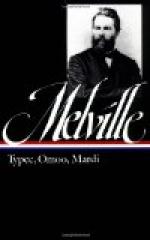Our way now led through the bed of a shallow water-course; Mohi observing, as we went, that our feet were being washed at every step; whereas, to tread the dusty earth would be to desecrate the holy Morai, by transferring thereto, the base soil of less sacred ground.
Here and there, thatched arbors were thrown over the stream, for the accommodation of devotees; who, in these consecrated waters, issuing from a spring in the Morai, bathed their garments, that long life might ensue. Yet, as Braid-Beard assured us, sometimes it happened, that divers feeble old men zealously donning their raiment immediately after immersion became afflicted with rheumatics; and instances were related of their falling down dead, in this their pursuit of longevity.
Coming to the Morai, we found it inclosed by a wall; and while the rest were surmounting it, Mohi was busily engaged in the apparently childish occupation of collecting pebbles. Of these, however, to our no small surprise, he presently made use, by irreverently throwing them at all objects to which he was desirous of directing attention. In this manner, was pointed out a black boar’s head, suspended from a bough. Full twenty of these sentries were on post in the neighboring trees.
Proceeding, we came to a hillock of bone-dry sand, resting upon the otherwise loamy soil. Possessing a secret, preservative virtue, this sand had, ages ago, been brought from a distant land, to furnish a sepulcher for the Pontiffs; who here, side by side, and sire by son, slumbered all peacefully in the fellowship of the grave. Mohi declared, that were the sepulcher to be opened, it would be the resurrection of the whole line of High Priests. “But a resurrection of bones, after all,” said Babbalanja, ever osseous in his allusions to the departed.
Passing on, we came to a number of Runic-looking stones, all over hieroglyphical inscriptions, and placed round an elliptical aperture; where welled up the sacred spring of the Morai, clear as crystal, and showing through its waters, two tiers of sharp, tusk-like stones; the mouth of Oro, so called; and it was held, that if any secular hand should be immersed in the spring, straight upon it those stony jaws would close.
We next came to a large image of a dark-hued stone, representing a burly man, with an overgrown head, and abdomen hollowed out, and open for inspection; therein, were relics of bones. Before this image we paused. And whether or no it was Mohi’s purpose to make us tourists quake with his recitals, his revelations were far from agreeable. At certain seasons, human beings were offered to the idol, which being an epicure in the matter of sacrifices, would accept of no ordinary fare. To insure his digestion, all indirect routes to the interior were avoided; the sacrifices being packed in the ventricle itself.
Near to this image of Doleema, so called, a solitary forest-tree was pointed out; leafless and dead to the core. But from its boughs hang numerous baskets, brimming over with melons, grapes, and guavas. And daily these baskets were replenished.




